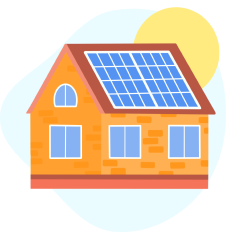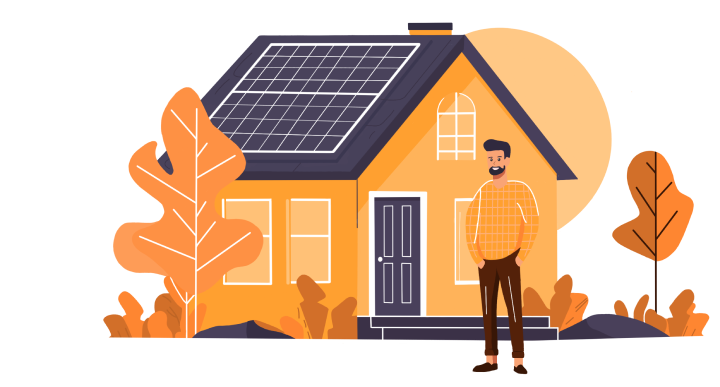Curious about the residential solar installation cost and how it impacts your decision to go solar?
Trying to figure out the average cost of solar panels can feel overwhelming, especially with the abundance of information available. From upfront expenses to the potential for long-term savings, it's crucial to grasp the different factors influencing any residential solar cost before you install a solar panel.
Here at Solar Energy Host, we aim to provide you with clear and concise information to help you make an informed decision without the hassle of sifting through technical jargon and trying to understand residential solar installation cost options.
What are the cost differences among monocrystalline and polycrystalline?
Performance vs. price: How does panel type impact both?
Monocrystalline panels are known for their high efficiency, around 22%, meaning they generate more electricity per square foot. Because these panels convert more sunlight into electricity compared to others, they require less space for installation. However, this efficiency comes with higher residential solar prices, making them the most expensive option.
Polycrystalline panels, on the other hand, offer a lower efficiency range between 15% and 17%, which means they need more space to produce the same amount of power as monocrystalline panels.
Monocrystalline panels may cost more upfront, but their efficiency and longer lifespan can save you money in the long run. This is an essential consideration when evaluating the overall cost of solar panel installation.
How can Solar Energy Host help?
Before you decide to install a solar panel, you should consider various factors such as the type of panel, the efficiency rate and the long-term savings. At Solar Energy Host, we simplify solar panel choices by providing clear comparisons of the types and their long-term savings potential.
How do labor and roof design influence solar installation expenses?
More complex roofs mean more hours and higher costs.
Roof design plays a big role in total costs. If your roof has multiple levels, steep slopes or obstacles like skylights, it takes more time and effort to complete a solar installation, thus increasing the residential solar installation cost for labor.
How the installation components determine your project's price tag.
When planning a solar installation, home solar installation cost will be influenced by several factors like the type of panels chosen, the mounting systems, and any additional upgrades to your home's electrical system.
Both monocrystalline and polycrystalline panels each come with their own set of costs and benefits. Additionally, the mounting system you select—whether standard or specialized—will influence the overall expense. Beyond panels and mounts, costs can also rise if you need to install inverters or upgrade your home's electrical system to accommodate the solar setup.
How local laws and climate shape solar costs
Installing solar panels comes with local permitting requirements that vary by area.
In some places, you might need multiple permits, such as building and electrical ones, which not only slow down the installation process but also add to your residential solar installation cost.
Additionally, navigating through these bureaucratic procedures can be overwhelming and often necessitates the help of experts who are well-versed in your local regulations, which can further elevate costs.
However, some regions offer incentives or have simpler rules, which can help lower any residential solar installation cost.
Climate plays a big role in the performance of solar panels.
For instance, an area with lots of sun will naturally get better performance from a solar power installation compared to a cooler, cloudier place. This means that solar systems in sunnier climates can generate more electricity, potentially leading to lower electricity bills over time.
Conversely, in areas where sunlight is less abundant, you might need more panels or advanced technology to achieve similar performance, which can increase your upfront residential solar installation cost.
Choosing the right system for your local weather can help you get the most energy and save money over time.
Leverage federal tax credits for immediate savings on solar installations.
When you install solar power for your home, you can claim a federal tax credit (Investment Tax Credit or ITC) on the cost, which applies to both equipment and installation costs.
Other government incentives come in various forms, such as tax exemptions, direct cash rebates or Renewable Energy Credits (RECs) that you can sell for extra income. By stacking these local incentives with the federal tax credit, you can significantly lower your initial investment and shorten the payback period for your solar system.
It's wise to check with local providers and government agencies to find out what specific solar panel rebates rebates are available in your area. You can also ask your provider for help about maximizing these benefits.
Frequently Asked Questions (FAQ)
What are the common misconceptions about the cost of solar installation?
A common misconception is that solar panels are too expensive for most homeowners.
The reality is that residential solar installation cost has significantly dropped over the years, making it more accessible for a larger number of households. Solar panel financing options, government incentives and tax credits have further reduced the financial barrier.
Plus, with Solar Energy Host, you can get a deal on your solar installation. Just provide some details and receive quotes from different solar installation companies, so you can pick the one that suits your needs and budget.
Can I sell excess electricity back to the grid, and does it offset my costs?
Yes, after a successful solar power panels installation, you can benefit from net metering by sending extra electricity back to the grid and earning credits.
Net metering is a system that allows you to feed excess electricity generated by your solar panels back into the grid. When your panels aren't producing, like at night, you can use these credits to offset the solar panel price of electricity you draw from the grid.
Are there additional costs for installing a solar battery or energy storage system?
Yes, adding a solar battery comes with extra costs, but it allows you to store energy for later use, like during outages or at night.
The initial solar energy cost for installation is higher compared to just having solar panels. However, a battery enhances energy independence by storing excess power for use during times when the panels aren't generating electricity.
Solar Energy Host: Your trusted solar partner
Solar Energy Host is your reliable partner in getting savings through solar installation. Get started with our platform today—just provide some details and receive different quotes from top providers in your area to get the best deal.




















